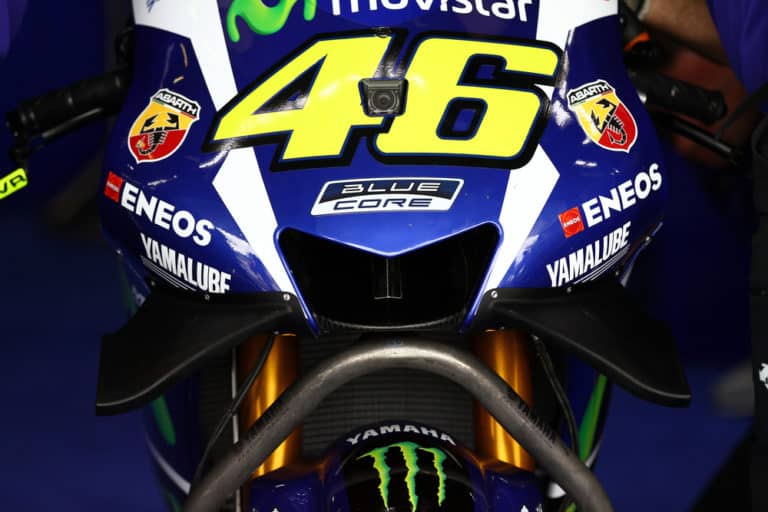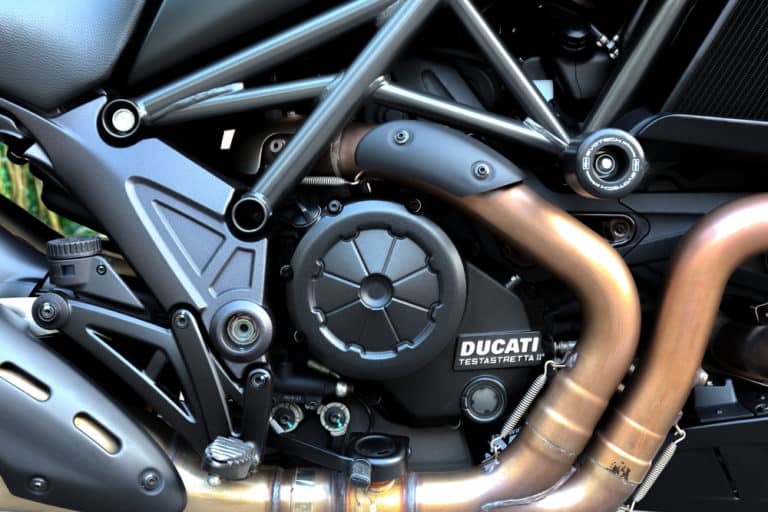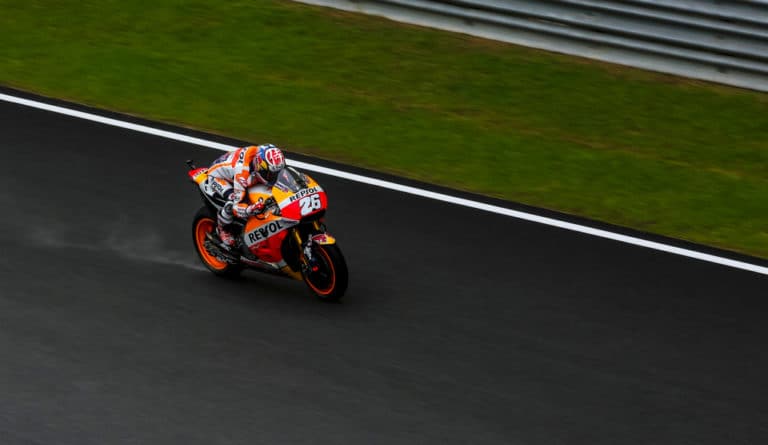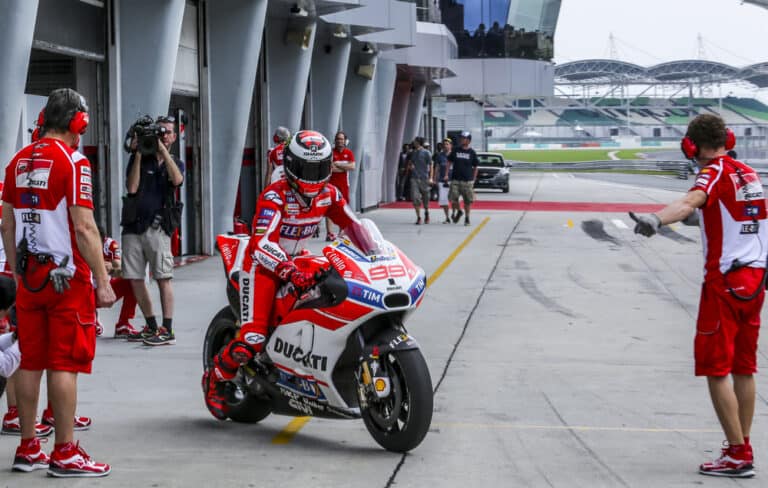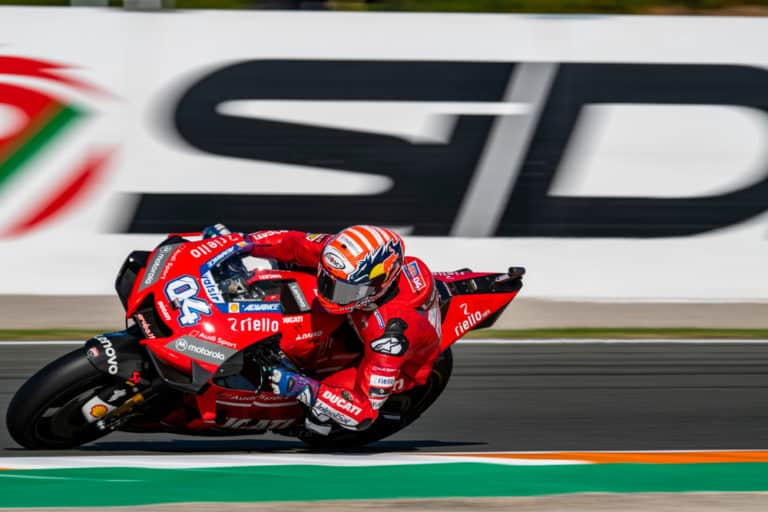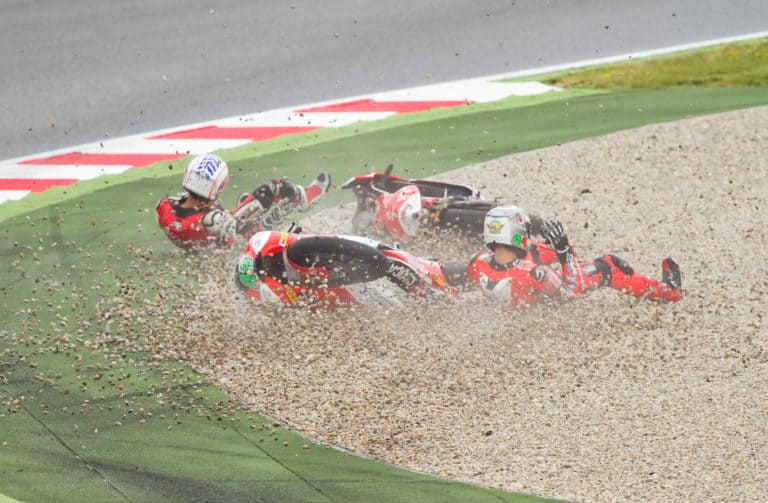Unlike car racing, MotoGP is a sport where you see everything that is happening. The riders can be seen adjusting the machine’s balance with their bodies. The races are typically considerably closer than most other forms of motorsport. Because they last 40 to 45 minutes, you can watch the entire thing without the bikes needing a tire change or anything like that. However, what is MotoGP racing?
MotoGP is a motorcycle championship that works with different manufacturers to create motorcycles that meet certain specifications. The FIM, an abbreviation for the Federation of International Motorcycles, whose main parent company is S.L. Dorna, regulates this sport.
There is no doubt that MotoGP has made a name for itself, and with good reason. Here is information about what MotoGP racing is, how it works, and many more.
What Is MotoGP Racing, And What Does It Consist Of?
In the sport of MotoGP, various motorcycle manufacturers alter their bikes and employ riders to compete against those from other manufacturers and their motorcycles. These competitions are conducted on FIM-certified circuits.
There are several teams in it, although there are primarily two kinds. Those are Factory and Satellite teams. Those who ride factory-supported motorbikes are referred to as Factory riders, while those who ride satellite bikes are referred to as Satellite riders. Each team may have two riders, with a third rider serving as a wildcard rider in some competitions.
Throughout the seasons, the official factories provide funding and support for Factory teams. These are Honda, Yamaha, and Ducati, for instance. In contrast, factory teams give Satellite teams bikes and supplies on loan. However, these bikes are not the latest.
They typically receive motorbikes that are a year older than what the factory riders get. For instance, Tech 3 Yamaha, LCR Honda, and Pramac Ducati. Any team that receives funding indirectly from a factory is considered independent. This applies to all factory satellite teams as well.
Roughly 12 teams are vying for the title. The riders each receive a bike from a different brand, such as Suzuki, Honda, Yamaha, Aprillia, or the recently joined KTM, all with the same form and design. Each racer will work on their bike setups with their crew and crew chief throughout the season.
During Free Practices, one to four, the rider will have time to practice the specific circuit. The rider’s best time on the track is determined. It is then structured so that he is either making the qualifying run in Q1 or Q2, depending on where he finished. The 4th Free Practice is generally just an additional practice session designed to extend the track time and improve the track experience.
In MotoGP, pit stops occur, but not as frequently as they would for F1 drivers. Only under certain situations, such as flag-to-flag races, which is when the riders must switch bikes owing to poor weather or recently resurfaced or rapidly drying tracks, or when the race is stopped because of a red flag. In this case, the riders go into the pit so the race can be restarted once further announcements are made.
What Is The MotoGP Point System?
MotoGP’s point system is somewhat similar to that of Formula One. First place gets awarded 25 points. 20 for those in second place, 16 for third, 13 for fourth, 11 for fifth, 10 for sixth, 9 for eighth, 8 for ninth, 6 for tenth, 5 for eleventh, 4 for twelfth, and 3 for fourteenth. 15th position only gets 1 point.
Each race counts toward a rider’s overall point total, which determines the champion at the conclusion of the year. Only those that are in the top 15 finishers receive points. The winner is the rider who has the most first-place finishes, second-place finishes, etc. That is if the points are tied, and the riders themselves are tied.
Suppose the race is halted for a specific reason and cannot be resumed with roughly less than two-thirds of the race distance completed. In that case, there is an exemption to this scoring rule. This could be brought on by poor weather or substantial track contamination. Half the points are given in this instance.
How Are Starting Positions In MotoGP Determined?
As with Formula 1, a specific procedure is followed when deciding which racer will start in the race and from which position. The MotoGP schedule is as follows:
Friday is Free Practice 1, 2, and 3. Saturday is when the fourth frame practice takes place. Qualifications 1 and 2 also happen on Saturday, with the race occurring on Sunday. To determine the riders’ placement in Q1 and Q2, the aggregated time sheet from Free Practice’s 1, 2, and 3 is calculated.
From the aggregate time sheets, the top 10 riders advance directly to Q2, while the remaining riders compete in Q1. The riders who finished in the top two in Q1 are given a second chance to race in Q2. These determine the final grid position for the race. With a margin of 1-2 meters between each driver, the one who completes the lap in the quickest time starts in pole position.
The following day, competitors start the race from their assigned starting places. Depending on the conditions, the race lasts between 40 and 45 minutes. To finish the race, the biker must travel 119 kilometers. Each Qualifier is 15 millimeters long. The length of each Free Practice is 45 minutes. This is for Free Practice 1, 2, and 3. The 4th Free Practice, on the other hand, is 30 minutes.
Are There Different Championships In The MotoGP Season?
There are various types of championships in a MotoGP season. The engine manufacturer wins the constructor championship. Since all of the bikes in Moto 2 have the same engines, the chassis manufacturer wins the constructor championship. According to the top finisher of that manufacturer, points are awarded.
The team wins the team championship. The points are awarded based on the team’s top finisher. Suppose two riders from a particular team finish first and second. The highest finisher’s points, which would be 25, according to the point system mentioned above, would be the points used.
Unlike Formula 1, where both rider’s points are combined, MotoGP only considers the highest riders score. Therefore the points awarded will not be 25+20. The most well-known championship is the Rider’s Championship. The fastest Qualifier is also granted a BMW M Award. Riders receive points in the same manner as during the race.
However, this award takes their qualifying place into account rather than their finish position. The fastest rookie receives the award for rookie of the year. At the conclusion of the season, the rookie with the most points is given the prize. Only Moto G.P. is eligible for this award; Moto2 and Moto3 are not. There is also a points chart that is available to compare independent riders.
All About MotoGP Racing Bikes
The motorcycles used in MotoGP are specialized racing motorcycles that cannot be lawfully driven on public roads and are not sold to the general public. Two-stroke engines are prohibited, and the largest engine size allowed is 1000cc. This bike must have at most four cylinders and an 81 mm maximum bore.
Each rider with a permanent contract can use a maximum of seven engines during the season’s scheduled races. As of 2016, all MotoGP bikes utilize a standardized software set known as unified software. Due to the rising expense of developing electronics, this was put in place to provide newer manufacturers like Aprilia, Suzuki, etc., a better chance of competing in the World Championship.
The competitors’ average speed throughout the race is 160 km per hour, while their highest speed is close to 320 km per hour. The bikes have a weight of about 160 kg and almost 250 hp. The motorcycles’ incredible power-to-weight ratio enables them to reach 100 km per hour speeds within only 2.6 seconds.
Each bike is meticulously crafted by hand and tailored to the individual needs of each rider. Let’s not forget the technology involved. Pneumatic valves, as opposed to spring valves, are used on MotoGP bikes.
Additionally, the MotoGP motorcycles in the lead have uninterrupted transmissions that enable swift clutchless shifting. The bikes also contain between 30 and 40 sensors that collect information about things like brake, steering angle, exhaust temperature, and suspension travel. The data is retrieved and examined after each race or even a practice session.
They have numerous single-use components. To offer the grip required to prevent the bikes from slipping off the track throughout the corners, the tires, for instance, are composed of soft, stickier compounds than conventional tires. These, however, have a very short lifespan and are discarded following each race or training.
Many MotoGP racers use the left thumb brake and the right foot pedal to control the rear brake. They don’t use it, though, like most superbike or road riders. They utilize it to maneuver the bike over turns and balance, guide and lever it. Rear-wheel braking lessens front-end dive and relieves some of the pressure on the front tire.
It also ensures that the front end stays down when applying the power and overall aids in maintaining the bike’s balance. It’s complicated, but as an illustration, a lot of riders will use their rear brakes practically every time they turn, during the run-in, then through the apex, and all the way to the power-out.
How Do MotoGP Bikes Start?
MotoGP bikes have no battery, starter, alternator, or kick start. The starting block is typically used to start these bikes. These starters are commonly employed in the paddock. If the bike stops in the middle of a track, the rider must push ferociously and kick start the motorcycle.
Similar to how you push start a vehicle or car, starting blocks function similarly. Here, the back wheel is hoisted and set on the starting block’s rollers, which rotate when a button is pushed and are electrically powered. The bike will start when you simply shift into gear and release the clutch. The clutch is the most crucial factor and a component of the mechanism.
That little device aids in connecting the engine’s crankshaft output to usage through the transmission, gearbox, and ultimately at the rear wheel. Generally, any object with mass at rest would be propelled into motion at some energy expense by applying some force.
The clutch is permanently present in the middle of the crank and transmission drive. As a result, anytime you engage or release the clutch, some power is taken away from the powerful engine. Nobody wants to lose even a little of the engine’s power.
Because doing so causes the bike to lose speed, wears down the rear tire from a rapid increase in traction, and requires more fuel to reach the top speed again. Therefore, MotoGP bikes are made in a way that keeps the weight of the clutch component to a minimum. That becomes interchangeable with fragile. If riders are not careful, the clutch plates can catch fire.
Therefore, the motorcycles are typically pushed to the starting line. This is to help the clutch function longer, permit the racer to crank the engine until it reaches the proper operating temperature, and lengthens the tires’ lifespan.
A light clutch has the additional benefit of minimizing power loss when shifting up or down. While the rider changes gears, hardly roughly 1000 rpm are lost on the motorcycle. The motorcycles employ starter units to ignite, maintaining the concept of a light clutch. The motorcyclists never start the bike rolling from a stop by applying the clutch.
MotoGP Racing Styles
In the 1990s, the prevailing riding fashion style was somewhat old school. Due to advancements in bike chassis, it is now completely outdated. In exchange for stability, the style sacrifices acceleration. The other riding style is more balanced.
The riding style is preferred by seasoned athletes. It has the perfect blend and attempts to fuse the rider with the bike. Although stable, it accelerates through turns at a breakneck speed. One that may look weird but works is when the rider has their elbows up. It targets the quicker outside line and aids in maintaining a steady lean angle.
However, it exhausts the body and can only be completed by those with endurance. A select few people use this distinctive style. Young riders quickly learn to maintain the ideal lean angle by grazing their elbows. Particularly useful on courses like Mugello that include off-camber turns.
The craziest overall style, where the body is almost wholly leaning out, is also the best for challenging tracks. Greater corner speed is possible, but it is far less stable. When done correctly, the fairing holds the entire torso out, which aids in mounting or descending corners.
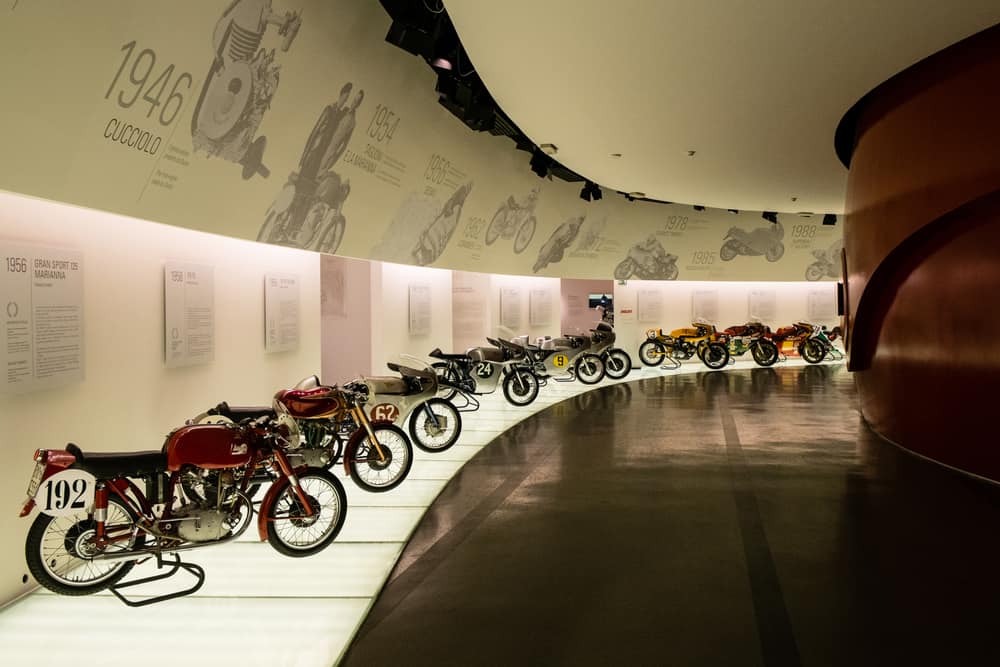
Does MotoGP Have History?
MotoGP is another racing sport with a real-time history that shaped what this sport is today. The Federation of International Motorcycles, the sport’s regulatory body, organized the first-ever motorcycle World Championship in 1949.
Before the Second World War broke out, a championship series was mentioned. In 1938, an eight-race European series that included the Isle of Man TT, France, Dutch TT, Germany, Grands Prix in Belgium, and Switzerland was held.
Even though it wasn’t entirely representative, Germany nonetheless won the championships. The year after, Germany’s example was followed by Italy, as they both achieved sporting success. Meanwhile, Norton bowed out from racing to focus on building gear for military uses. The European Championship was initially scheduled to span nine rounds.
However, because of the start of the war, it was reduced to seven, and bike racing was put on hiatus for six years. The foundation for a championship series was thus laid once racing began in 1946. Interestingly, it is still unclear why the plan was shelved in 1947 and 1948, and the races instead continued as stand-alone events.
But in 1949, the FIM chose to bring back the concept of a series of series, giving them the name World Championship to give their decision more prestige. It marked the beginning of what would be known as the Grand Prix World Championship that we are all familiar with today. It ushered in a new era for global motorcycle road racing.
Six races occurred for the 500cc class, with five for the 350s, and four for the 250s, then three for the 125s and sidecars in that inaugural year of 1949, which may have been a pale imitation of the World Championships of the more recent years. However, it was a start.
British manufacturers initially dominated the 1950s until being overtaken by German and Italian manufacturers. However, British riders won the 1949 titles for 500cc and 350cc. The Italians performed better in the smaller classes. This was a sign of things to come for them.
The British machines ultimately prevailed because of their dependability, but Norton had to meet the challenges because of the Gileras’ noticeable speed. The Honda brand made its debut at the Isle of Man TT in the year 1959, ushering in a transition that saw Japan take over all except the 500cc class.
The first year did not foretell what was to come, but Honda quickly picked up new skills, and in 1960 they went back to Europe with brand-new 125cc and 250cc machines. Suzuki’s expectations were primarily limited to 50cc and 125cc classes.
In contrast, Honda was a world championship challenger in every class bar, excluding the 500cc one. Upon winning the 50cc title in 1962, Suzuki earned their first World Championship. Yamaha’s offensive mainly targeted the 125cc and 250cc divisions.
Suzuki and Kawasaki joined Yamaha. Honda was also making a comeback in 1982 with the two-stroke NS500cc motorcycle. After making an unsuccessful four-stroke come back in 1979, the two-strokes dominated the motorcycle market in the 1980s and 1990s, as well as for Australians and Americans.
How Has The Point System Changed From Back Then?
The process for awarding points has evolved throughout time. In 1949, the top five finishers for each race received points as follows: 10, 8, 7, 6, and 5, with an additional point if they turned in the quickest lap. The following year, the award for the lap completed the fastest was removed. Instead, it was now the first six racers that received points: the winner received 8, followed by 6, 4, 3, 2, and then 1.
The World Championship did not consider every rider’s points during this time. Until 1969, when points were only handed up to the tenth-place finisher, this points system was still in use. The winner received 15 points, while the next nine competitors received 12, 10, 8, 6, 5, 4, 3, and 1 points.
Having fewer races that a rider may choose to ignore was the goal. Therefore, the FIM implemented another new method in 1976. This new method included adding a rider’s top three results from their first five rounds to his top three results from the rest of the remaining five rounds to determine his overall point total.
However, that point system lasted for merely one year. From 1977 onward, all rounds were included in the overall total of a rider. Another change that took place in 1988 was that points were awarded to the first 15 finishers.
This was apart from 1992 when the system awarded points to those that were among the first ten to finish. Racers in the first 15 positions subsequently received points. The system was altered once more in 1993, with the top three finishers getting 25, 20, and 16 points, respectively, while positions four through fifteen remained unchanged. This approach is the one that you see being used today.
Conclusion
MotoGP is a motorsport that many love as it enables spectators to see every move, making them feel like they are a part of the race. Looking at the history, you can see how much work, changes and effort were needed to make it the motorbike sport that it is today. The prototype bikes have no doubt raised the bar of bike racing.

